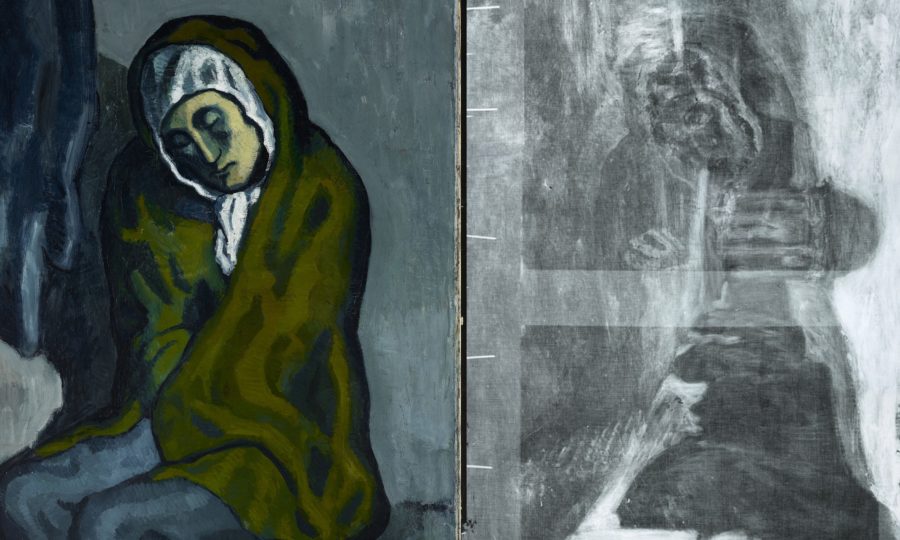Art, with its myriad of interpretations and forms, has always captivated the human spirit. Its history is a complex web of stories, revelations, and hidden gems, and none is more intriguing than the mysterious layers that often lie beneath the surface of great works. This is particularly true for the masterpieces of renowned artists like Pablo Picasso, whose depth of creativity continues to surprise and enlighten us to this day.

A Window into the Artist's Studio
The art world has recently witnessed an astounding development that is reshaping our understanding of the past: the unveiling of hidden layers beneath Pablo Picasso's "La Misereuse Accroupie," also known as "The Crouching Woman." This progress is due in no small part to the innovative scanning techniques being employed by researchers at Northwestern University. What might have remained concealed for centuries is now coming to light, offering us a window into Picasso's studio.
The technique at the forefront of this revolution is X-ray fluorescence (XRF). It is a method that sounds more at home in a scientific laboratory than an art gallery. Yet, its power lies in its non-invasive nature, which allows experts to explore the elemental makeup of an artist’s palette without damaging the precious artwork. Through XRF, researchers can determine the chemical elements present in the paint, providing clues to the pigments Picasso used during his Blue Period, a time known for its melancholic beauty and subdued, monochromatic tones.
Discovering the Barcelona Landscape
Beneath the layers of "La Misereuse Accroupie," researchers have uncovered something remarkable: a landscape of Barcelona, reoriented and repurposed. The hilly terrain, once standing upright, now serves as the backbone of the crouched woman. This discovery offers a tangible glimpse into Picasso's transformational creativity, revealing his ability to repurpose and see beyond the conventional, thus forging a visceral connection between his artwork and his Spanish heritage.
Implications for Art History
The implications of such a discovery are profound. The concept of a painting being a singular, static entity is challenged; instead, we are encouraged to view these works as dynamic narratives, continuously unfolding. Art historians and conservators now have the unprecedented opportunity to delve into the mind of the artist, to witness the evolution of a masterpiece. It is akin to being given a map to an artist's creative journey, which not only sheds light on their methods but also on their personal struggles and triumphs.
Enhancing Conservation Efforts
For the conservators tasked with the care of such invaluable works, XRF scanning is a godsend. It is a method that respects the sanctity of the artwork, eschewing the invasive tactics of the past that risked damaging the artworks for the sake of analysis. This technological leap is changing the face of art conservation, allowing for a deeper understanding of the artwork without the threat of its degradation.
Cost-Effective Technology
The technology’s accessibility marks a democratization of art analysis. Smaller institutions and even individual collectors, who may have previously been priced out of such scientific insight, can now explore the depths of their collections. This breakthrough is leveling the playing field, making the innermost secrets of art accessible to a broader audience.
Picasso's Blue Period Uncovered
Picasso’s Blue Period, a time when the artist was engrossed in the exploration of human misery and alienation, is rendered even more poignant with these new findings. It appears that during this time, Picasso often painted over existing works, embedding his emotional state into his canvases. Now, each Blue Period painting is seen not just as a window into the artist’s soul but also as a potential archive of hidden stories.
A New Perspective on the Artistic Process
The ability to see beneath the visible layer of paint gives us a unique vantage point, almost as if we are standing beside Picasso as he applies each stroke. This novel perspective reorients our relationship with the finished artwork. Knowing what lies beneath, our appreciation is deepened, our understanding heightened, and our interpretation inevitably altered.
Unprecedented Insights into Artistic Evolution
Researchers are now able to chart an artist’s stylistic and technical development in ways previously unimaginable. With "La Misereuse Accroupie," for instance, the interplay between the original landscape and the final composition is a direct testament to Picasso's innovative spirit—his ability to see the human form within the abstract, to bend nature to his artistic will.
The Future of Art Research
The advancements in XRF scanning technology promise a thrilling future for art research. As the technology evolves, it will continue to peel back the layers of history, revealing new truths about old masters. This is a burgeoning field where art meets science, a symbiosis that is transforming our understanding of artistic legacy.
In conclusion, the revelations unearthed beneath "La Misereuse Accroupie" represent more than just a scientific triumph; they symbolize the dawning of a new chapter in art history, a renaissance of discovery that melds the technological with the historical, the analytical with the aesthetic. As the implications of this technique continue to ripple through the art world, the profound complexity of creation is laid bare, revealing the extraordinary lengths to which artists like Picasso went to express their innermost thoughts and emotions.
Picasso's work, monumental in its own right, now takes on new dimensions of meaning. It is no longer just the visible surface that captivates but the hidden depths that await discovery. The crouched woman, once thought to be a solitary figure, is now a synthesis of landscapes, emotions, and history, a layered narrative etched in oil and pigment, waiting to be read by those willing to look beneath the surface.




